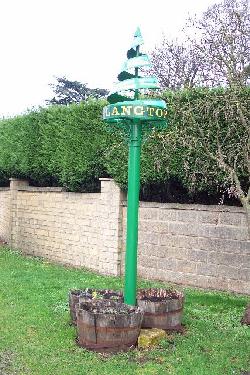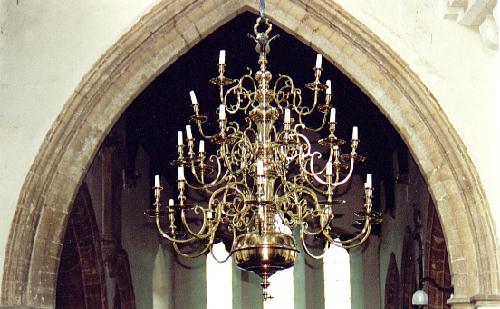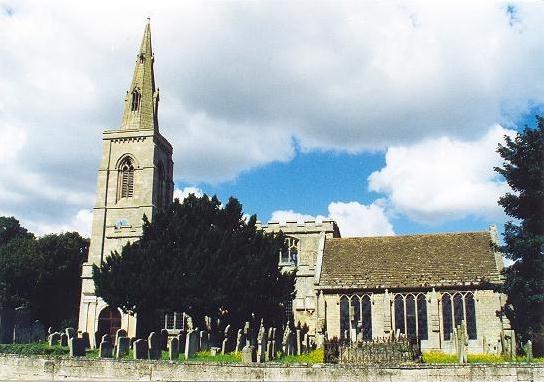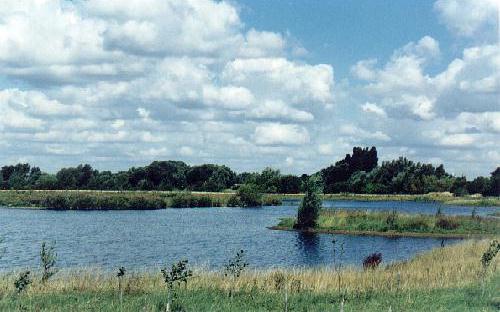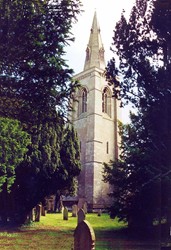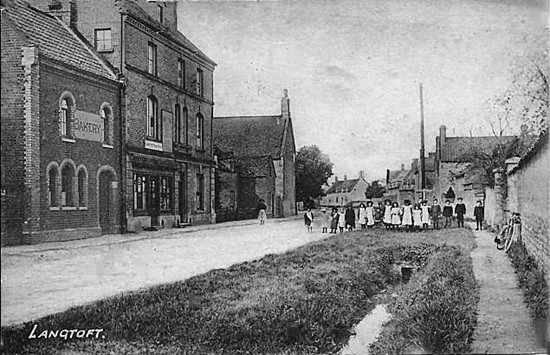|
Langtoft
The art work on the eye-catching sign depicts life in the village past and present including the occupation by the Romans, gravel extraction, farming, the church, old school, village hall and primary school and sports field, and was completed by sign writer Tony Warren of Deeping St James. The project was funded by the Langtoft Millennium Group and a grant of £825 from South Kesteven District Council. The church of St Michael and All Angels has seen many changes during its 700 year history but is still impressive with its great array of battlements and many variations of style, the oldest part being the tower with its clasping buttresses and capped with the 15th century spire, curiously set at the west end of the north aisle, while the south porch is an attractive, early 18th century addition.
The arcades are 14th century and the pillars 13th century while the arches are adorned with little heads of mediaeval men and women that look down upon the congregation. Unusually, there are no stained glass windows in the chancel or nave but the clear mullioned lights provide a sense of space and the great west window particularly gives displays of a wonderful area of evening sun-drenched glass.
The old pulpit dating back to the 18th century has tarsia panels depicting flaming suns and sacred monograms and kneeling in a niche high up in the chancel is the figure of Elizabeth Moulesworth, in black Stuart gown and ruff. She died in 1648, three years before Sarah Walcot whose brass inscription on the floor speaks poignantly of her bereaved husband’s anxiety to join her.
An extensive programme of church restoration has recently been completed. The first phase began in 1994 after a survey revealed that major repairs were needed to the stonework, the spire and the leaded west window. The vestry was also given a new roof and redecorated. This work cost £40,000 and was financed primarily by grants from English Heritage, donations and fund-raising. The second phase was carried out in 2001 when a further £86,000 was spent on renovating the nave and again the money came from similar sources and although the church was closed for three months, the entire project was completed in time for the Christmas services. Floodlights were installed in September 2002 to illuminate the church at a cost of £5,000 which was raised by the family and friends as a memorial to Mrs Priscilla (Cilla) Diane Jackson, an active church member, of East End, Langtoft, who had died the previous April, seven weeks after being diagnosed with cancer. They will be known in the future as "Cilla's Lights". The restoration of the bells was completed in 2004 at a cost of £40,000 when they rang out for the first time in 33 years after being silenced in 1971 because the bell frame was deemed to be unsafe and to ring them might have damaged the tower. Two of the bells date from 1662, one from 1772, one from 1810 and the other from 1825, total weight being 2 tons 6½ cwt. All of the bells were refurbished and a sixth new one added. A day of celebration was held on Saturday 13th March to mark the event with a simultaneous peal in the three churches of the Ness group, Baston, Langtoft and Thurlby, and the formation of the Langtoft Chimers, a team of eight who will ring the bells regularly on Sundays from now on. Further work is now underway on the final phase and will include refurbishing the north and south aisles. Fund raising to pay for this work is currently underway. Churchwarden Mrs Claudette Peakman is optimistic that this will be achieved. "We have always managed to raise the money before and there is no reason why we should not do so again", she said. There was a Methodist chapel in the village, built in 1836 on a parcel of leased land, and although the cost of construction is not known, a debt of £67 still remained in 1862. Membership was never high, although 28 children were attending the Sunday School in 1851. But there were problems with the chapel itself and in 1895, the roof became unsafe and eventually collapsed and in 1902, the building was boarded up and abandoned. There was a revival of interest in Methodism in 1911 when the chapel used by the Congregational Church was leased but the new premises failed to sustain any lasting interest in the cause and it closed on 30th September 1931 and the building was returned to the Congregationalists. This chapel was eventually demolished and a private house has since been built on the site. Cottage meetings have been held as recently as 1953 in an attempt to revive Methodism in Langtoft but have met with little success. The village hall has been the centre of social activities in the village for almost 30 years. It was built in 1910 as the Langtoft Working Men's Conservative Club on land donated by the Earl of Ancaster and became the village hall in 1972 although these were the days of damp wooden floorboards, coal fires and outdoor toilets. A grant from the National Lottery fund in 1990 helped finance improvements to the building including a solid floor, gas-fired central heating, a kitchen and indoor toilets. The parish council meets here and among the events that are held regularly are productions by the local drama group, the Langtoft Players, whist drives, yoga classes, jazz sessions and even carpet bowls. The flag of St George regularly flies from a flagpole above the hall, bought with funds raised during the Golden Jubilee celebrations during 2002.
The owners of old stone cottages always seem anxious to establish the provenance of their properties and go to great pains to perpetuate the dates of construction. Many already have small stone plaques included in the frontage giving the date they were built and often the initials of the owner at that time, such as
those in West End, Langtoft. The oldest of these is Peartree House with the date 1839 and the initials PGS while a smaller cottage nearby has the date 1855 and the initials HWG.
Large tracts of land around Langtoft have been excavated for sand and gravel and these operations continue in several places. Once the aggregates have been exhausted, the holes created are left to fill with water and most are being reclaimed by nature with a little help from man who has planted trees and landscaped the banks to provide a very attractive rural scene. The pits are also a rich source of information for archaeologists and in March 2007 yielded artefacts from the Neolithic period. The most remarkable find was a wooden haft from a Bronze Age flint adze made from a single piece of wood. The dig, carried out by a team from the Cambridge Archaeological Unit, also unearthed a dump of boat-shaped vessels associated with the manufacture of salt, the first time it has been possible to make a conclusive dating of pre-Iron Age salt making in this part of the fens. Alison Dickens, the team leader, explained: "The site looks bleak now but in its day it would have been a busy area with round houses and granaries. We have also identified an east-west track running south of the excavation area which presumably connected with King Street, a major Roman road about two miles west of the site. We found a swathe of pits, wells and post hole structures dating from the late Bronze Age or early Iron Age periods which indicated settlements around the fen edge. There was also pottery and evidence of bronze and iron working as well as Romano-British settlements." The dig is part of an ongoing survey that began in 1998 but two mysteries remain unsolved. One concerns the buried skeletons of two large cows, one with a calf, whose size suggests that they came from the earlier Neolithic period. The other is of more recent origin: a malted milk tin found in a backfilled post-mediaeval pond which contained 97 pennies and 78 halfpennies dating from the Victorian period to 1950.
See also Fire in Langtoft REVISED JULY 2014
Go to: Main Index Villages Index |
|||||||||||||||||||||||||||
